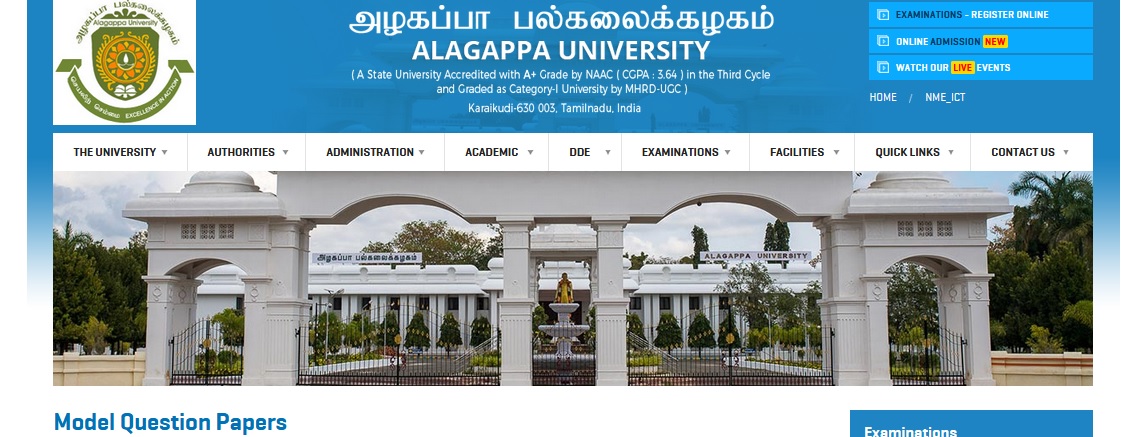Plant Biodiversity-I B.Sc Model Question Papers : alagappauniversity.ac.in
Name of the University : Alagappa University
Degree : B.Sc
Department : Botany
Subject Code/Name : Plant Biodiversity-I
Semester : I
Document Type : Model Question Papers
Website : alagappauniversity.ac.in
Download Model/Sample Question Paper : NOV 2010 : https://www.pdfquestion.in/uploads/alagappauniversity.ac.in/3977.-B.Sc.%20BOTONY%20CBCS.pdf
Alagappa Plant Biodiversity-I Question Paper
Part – A :
1. Biofertilizers.
2. SCP.
Related : Alagappa University Properties Of Matter And Acoustics B.Sc Model Question Papers : www.pdfquestion.in/3988.html
3. Agar-Agar.
4. Heterothalism.
5. Haustorium.
6. Usnea.
7. White Rust.
8. Gemma Cup.
9. Fungicide.
10. Horn Worts.

Part – B : (5 × 5 = 25)
Answer all questions
11 a. Write the methods of Reproduction in Volvox.
(Or)
b. Explain the structure of fungal mycelium.
12 a. Present the general characteristics of ascomycetes.
(Or)
b. How are lichens classified based on structure?
13 a. Give an account of the causes symptoms and control of citrus cancer.
(Or)
b. Give an account of the causes, symptoms and control measures of Bunchy top of Banana.
14 a. What is biological control? What are its advantages?
(Or)
b. Explain the physical methods of plant protection.
15 a. Describe the reproduction found in Anthoceros.
(Or)
b. Describe the general character of Bryophytes.
Part – C : (3 × 10 = 30)
Answer any three questions
16. Write an essay on the economic importance of algae.
17. What are mycorrhizae? What is their significance?
18. Write notes on :
a) Tikka desease of ground nut.
b) Little leaf of Brinjal.
19. In what way are quarantine measures helpful in the control of pests and diseases?
20. Explain the life history of polytrichum.
November 2010
B.Sc. Degree Examination :
Plant Biodiversity – II :
(Pteridophytes, Gymnosperms And Paleobotany) :
(CBCS—2008 onwards)
Time : 3 Hours
Maximum : 75 Marks
Draw diagram wherever necessary
Part – A : (10 × 2 = 20)
Answer all the questions
1. Synangium.
2. Ligule.
3. Valecular Canal.
4. Stomium.
5. Pycnoxylic.
6. Branches of Pinus.
7. Pseudofossils.
8. Palaeozoic Era.
9. Rhynia.
10. Birbal Sahni.
Part – B : (5 × 5 = 25)
Answer all questions
11 a. Write about the importance of seed habit in pteridophytes.
(Or)
b. Write about the structure of Synangium in Psilotum.
12 a. Describe the internal structure of marsilea sporocarp on different sectional views.
(Or)
b. Explain the strobilus of “Equisetum” with suitable diagrams.
13 a. List out characteristic features of the secondary Xylem of Pinus stem as known by its various sectional views.
(Or)
b. “Gnetum is a Gymnosperm, but possesses some strong angiosperm’’ features – Explain.
14 a. Write about the methods of determining the Age of Fossils.
(Or)
b. Write the significance of “Cenozoic era” in Geological Time scale.
15 a. Describe the structure of Lepidocarpon.
(Or)
b. Write notes on “Gymnosperm Fossils”.
Part – C : (3 × 10 = 30)
Answer any three questions
16. Give an account of stelar evolution in Pteridophytes with diagrams and examples.
17. Explain the external and internal structure of stem of Equisetum.
18. Describe the internal structure and secondary growth in the stem of Gnetum.
19. Define Fossil. Give its types and describe the methods of fossilization.
20. With suitable diagrams describe all the available pteridophytes fossil characters.
November 2011
B.Sc. Degree Examination
Cytology, Anatomy And Microtechniques :
(CBCS—2008 onwards)
Time : 3 Hours
Maximum : 75 Marks
Part – A : (10 × 2 = 20)
Answer all the questions
1. Cell Wall.
2. Grana.
3. Aeranchyma.
4. Companion cells.
5. Bark.
6. Cambium.
7. Magnifying Power of Microscope.
8. Formaldehyde.
9. Sectioning.
10. Haematoxylin.
Part – B : (5 × 5 = 25)
Answer all questions
11 a. Describe the structure and function of Plasma membrane.
(Or)
b. Explain the structure and function of Mitochondria.
12 a. Mention the different types of Collenchyma.
(Or)
b. Describe the structure of Xylem tissue.
13 a. Describe the structure of Dicot Leaf.
(Or)
b. Write an account on nodal structure in Angiosperms.
14 a. Explain the basic principles and mechanism of light Microscope.
(Or)
b. What are the parts of a compound Microscope? Mention their uses.
15 a. Mention the properties of fixatives.
(Or)
b. Classify stains based on their sources.
Part – C : (3 × 10 = 30)
Answer any three questions
16. Describe the ultrastructure of Plant cell.
17. What are Meristems? How are they classified based on origin, position, function and plane of cell division?
18. Explain the Anomalous Secondary growth in Boerhaavia with diagram.
19. Write a detailed account on Electron Microscope.
20. Define Maceration. Explain the methods employed for Maceration of woody tissue and preparation of permanent slides.
November 2012
B.Sc. Degree Examination :
Embryology Of Angiosperms And Plant Tissue Culture :
(CBCS—2008 onwards)
Time : 3 Hours
Maximum : 75 Marks
Draw diagrams wherever necessary
Part – A (10 × 2 = 20)
Answer all the questions
All questions carry equal marks.
1. Tapetum.
2. Syngamy.
3. Perisperm.
4. Monocot embryo.
5. Apogamy.
6. Male Sterility.
7. Callus.
8. Stomatic embryo.
9. Nucellus Culture.
10. Embryoids.
The method used to present a question is useful and more suitable for student to obtain more information and knowledge.